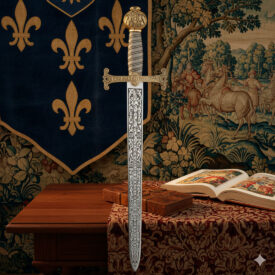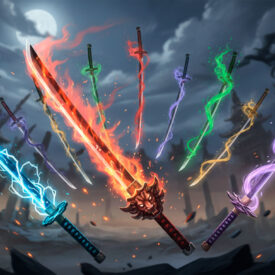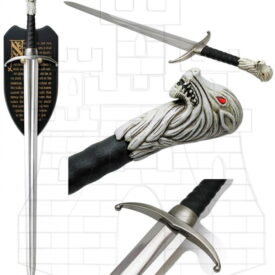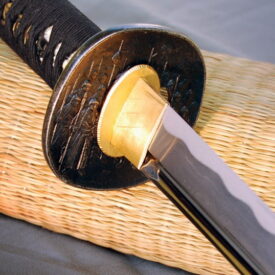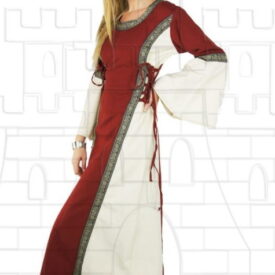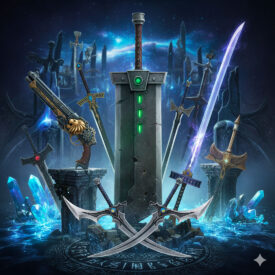What force lies within a blade that not only cuts flesh, but also cuts through history? The image of the Templar knight, his white mantle crossed by the red cross and a sword in hand, remains present in the collective imagination. But the Templar sword was much more than a weapon: it was an emblem, a ritual, and a mirror of the monk-warrior’s ideal. In this article, you will explore its origin, construction, symbolism, and the daily practice that turned steel into a symbol of service.

Where the Myth Comes From: Origins of the Templar Sword
The Order of the Temple was founded between 1118 and 1119 with a clear purpose: to protect pilgrims and guard the Holy Places. From its first steps, the sword became the ritual and functional object that defined the Templar. It was not merely a tool of war: it was the visible extension of an ethical and spiritual code.
In the foundational texts and in the Rule approved at the Council of Troyes (1128–1129), references to weapons already appear as part of the Order’s identity. The sword legitimized the figure of the knight who was, at the same time, monk and soldier: a paradox shaped by discipline, vow, and liturgy.
The Templar Sword: Historical and Ritual Milestones
The chronology clearly shows how the sword evolved from a military instrument to a ritual symbol and, finally, a legendary emblem. Below is the essential chronology that includes dates, regulations, and ceremonial uses:
| Date / Period | Event |
|---|---|
| 12th Century — Origins and Formalization | |
| 1118–1119 | Founding of the Order of the Temple as an initiatory Christian chivalric order; birth of the monk-warrior’s ideal. |
| 1128–1129 | Approval of the Rule of the Temple at the Council of Troyes; the sword is formalized as a central element of Templar armament and identity. |
| First half of the 12th century | The aristocracy of Aragon, Catalonia, and Portugal begins to donate arms and horses to the Temple to equip its encomiendas. |
| 1158 | Record of donations to the Templar encomienda of Huesca (documented example of arms delivery). |
| 12th–13th Centuries — Daily Use, Ritual, and Regulation | |
| 12th–13th Centuries | Documentation of continuous grants of arms and horses in encomiendas such as Barberá and Gardeny; the sword acquires strong symbolic significance (weapon of light, cross, double edge). |
| c.1165 | Retractions: early version of internal norms and regulations that complete Templar discipline. |
| 12th–13th Centuries | Initiatory and ceremonial practices: the aspirant kneels before the sword, takes it in the form of a cross; celebration of the accolade as an initiatory rite. |
| 1128–1267 | Period of regulation (Rule, Retractions, Statutes, and Considerations) that sets norms on the possession, care, and use of arms (prohibitions on burnishing or painting arms without permission; punishments for loss of the sword). |
| 12th–13th Centuries | Development of symbolism: the sword as an instrument of purification, spiritual power, and metaphor for the “tempering” of the knight’s soul. |
| 13th Century — Transformations and Limitations | |
| 1230–1240 | Drafting of the Hierarchical Statutes, which regulate the internal structure and discipline of the Order. |
| 1257–1267 | Publication of the Considerations, new regulatory versions that continue to discipline Templar life and the use of arms. |
| Late 13th century | Gradual decrease in arms donations in the Peninsula until almost ceasing at the end of the century. |
| Late 13th C. – early 14th C. | Testimonies of arms shipments to the Holy Land from the Peninsula; however, some monarchies (e.g., Aragon) restrict these exports. |
| 1290 | Prohibition by the Crown of Aragon of arms exports to the Holy Land in the context of regional conflicts. |
| 1307–1314 — Persecution, Public End, and Legacy | |
| October 13, 1307 | Mass arrest of the Templars by order of King Philip IV of France; beginning of the public dismantling of the Order. |
| 1314 | Execution of Jacques de Molay and other priors; the Order goes underground and an enduring legend is born about its spirit and symbols, including the Templar sword. |
Design and Proportions: Anatomy of a Templar Sword
Technical descriptions found in medieval sources and modern interpretation allow for outlining a recurring model of the Templar sword: a straight, double-edged blade, a cross-shaped hilt, and a solid pommel that balanced the weapon. These characteristics not only obeyed functional criteria but also carried intentional symbolic meaning.
| Characteristic | Typical Description |
|---|---|
| Length | 70–90 cm (blade), adapted for mounted and hand-to-hand combat. |
| Weight | 1–1.5 kg, designed for agile one-handed handling and shield use with the other. |
| Blade Type | Double-edged, tip suitable for thrusting and cutting; central fuller to lighten the piece. |
| Hilt | Latin cross shape, straight guard, and rounded or faceted pommel with iconography. |
| Material | Tempered steel (in modern replicas, stainless steel), brass or steel guard and pommel. |
Comparison with Other Contemporary Swords
- Viking Sword: wider blade and cutting-oriented; different aesthetics and combat technique.
- Norman Sword/Arming Sword: shares many functional similarities with the Templar sword; the difference lies in decorative details and iconography.
Forging and Maintenance: How Steel Was Made and Why It Mattered
The forging of a sword was a technical and symbolic process. The tempering of steel — heating, cooling, and reheating to give it adequate toughness — was as much a science as a spiritual metaphor among the Templars. Tempering the metal and tempering the soul were two sides of the same teaching.

Daily maintenance was also regulated: the Templar rule prohibited certain embellishment work without permission but required that weapons be operational and in good condition. Losing the sword could lead to sanctions, which underscores its practical and symbolic value.
Rituals Surrounding the Sword
During initiation, the aspirant knelt before the sword and took it in the form of a cross. The accolade, while similar to that granted to secular knights, here acquired an initiatory dimension: the sword sealed a spiritual commitment and marked entry into a lineage of service and discipline.
The Templar Sword in Combat: Tactics and Functions
In the heat of the Crusades, the Templars were known for their discipline and for acting as a shock force. The sword, light and balanced, allowed for effective attacks from horseback and quick maneuvers on foot. Accompanied by the shield, it formed part of a combined system of weapons and formation.
The Templars were also skilled in defensive tasks: they protected pilgrimage routes, fortified positions, and contributed to the rear guard during retreats. Their logistical experience and the quality of their armament were key factors in their military reputation.
Profound Symbolism: The Sword as Cross, Light, and Purification
The Templar sword synthesizes several levels of meaning:
- The cross shape: the union between blade, guard, and hilt evoked the Christian cross, recalling the knight’s redemptive mission.
- Double edge: symbolized the struggle between opposing forces and the need for balance between the material and the spiritual.
- Power and purification: the sword was seen as an instrument that destroys ignorance and restores justice, a function equivalent to the divine word in biblical metaphors.
Everyday Use and the Ethics of the Weapon
For the Templar, the sword was not a cause for ostentation. The Rule limited acts that sought personal glory (such as unnecessary tournaments) and favored humility. However, the sword continued to be a sign of authority and responsibility: defending the needy, maintaining internal order, and acting with justice.
The relationship between the knight and his sword was almost pedagogical: through the handling of the weapon, discipline, patience, and self-control were taught. In that sense, the sword was a tool for moral improvement.
Presence in the Iberian Peninsula: Donations, Encomiendas, and Shipments to the Holy Land
During the 12th and 13th centuries, the Templars received numerous donations from the Peninsular nobility: arms, horses, and lands. Records in encomiendas such as Huesca, Barberá, and Gardeny document these contributions and show the strategic importance of the Order in the region.
Part of the armament remained in the Peninsula for local defense; another part was sent to the Holy Land. Over time, and due to political tensions, some monarchies, such as the Crown of Aragon, imposed restrictions on the export of arms at key dates such as 1290.
These logistical movements reveal that the Templar sword was also a social and economic good: its circulation depended on donations, agreements, and strategic needs.
Replicas and Material Memory: How the Sword Is Interpreted Today
Modern replicas seek to reproduce historical aesthetics and proportions. Many contemporary catalogs describe silver-plated hilts with inlays and stainless steel blades that emulate the shine and resistance of the original. Although replicas use current materials, they try to preserve the spirit of the piece.
It is essential to differentiate between historical value and symbolic value. A replica is not equivalent to a relic, but it allows for understanding proportions, weight, and ergonomics. Furthermore, the mere contemplation of a well-made blade evokes Templar discipline and aesthetics.
Comparative Table: Historical Specifications vs. Modern Replicas
| Aspect | Historical Sword (12th–13th centuries) | Modern Replica |
|---|---|---|
| Blade Material | Carbon steel, forged and tempered | Stainless steel or carbon steel treated for preservation |
| Weight | 1–1.5 kg | 1–1.6 kg (depending on decorations) |
| Decoration | Prudent, symbolic; simple crosses or marks | Inlays, polished finishes, and historical ornamentation |
| Function | Military and ritual use | Decorative, collecting, historical reenactment |
Beyond the Legend: The Decline, Persecution, and Persistence of the Symbol
Friday, October 13, 1307, marked a before and after: the raid ordered by Philip IV of France initiated the public disbandment of the Order. The execution of Jacques de Molay in 1314 sealed the visible end of an institution, but it did not extinguish its myth. The Templar sword survived in memory as an emblem of sacrifice, service, and wisdom.
Persecution transformed everyday objects into symbolic relics. The sword, which had been regulated, used, and cared for, came to represent a broader quest: the preservation of the chivalric ideal in times of uncertainty.
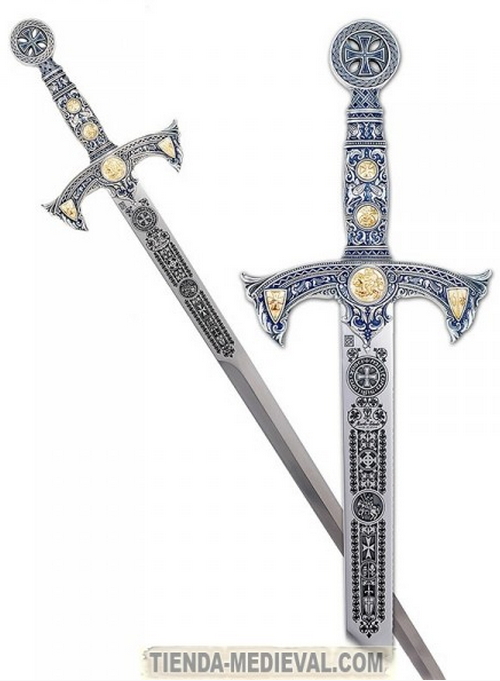
How to Understand the Templar Sword Today: Historical and Emotional Reading
When looking at a Templar sword, it is important to separate layers: the technical (forging, proportions), the practical (use in battle and rituals), and the symbolic (values, devotion, discipline). Each of these layers helps to understand why the figure of the Templar and his weapon continue to captivate.
For enthusiasts, scholars, or historical reenactors, the sword is an entry point into a complex era. It represents political decisions, the economics of war, spirituality, and the constant tension between monastic and military life.
Tips for Preserving Knowledge (not prices or purchase recommendations)
- Document: preserve images and references of historical pieces and archives on encomiendas and donations.
- Understand: study the Rule of the Temple and documentary sources from the 12th–13th centuries to contextualize the use of arms.
- Respect: treat replicas as didactic tools: they allow for practical approximations but do not replace historical research.
Living Legacy: Why Templar Swords Continue to Inspire
The Templar sword has endured because it combines aesthetics, function, and myth. It is a bridge between medieval craftsmanship and contemporary narrative. Its simple lines and contained symbolism ensure that it remains a powerful cultural icon: inspiring for reenactors, artists, and scholars.
Every inscription, every guard, and every pommel tells stories of discipline, dedication, and struggle. That is why, centuries later, we continue to read the blade as if it were a text that speaks to us of the past and, at the same time, questions us about the present.
Explore these pages with a critical and curious spirit: knowing the Templar sword is to understand an essential part of Christian chivalry and its influence on the formation of medieval Europe.

